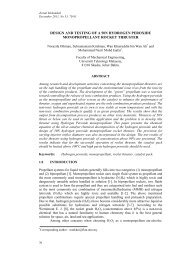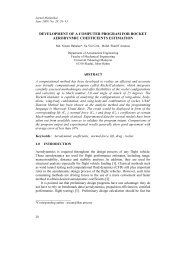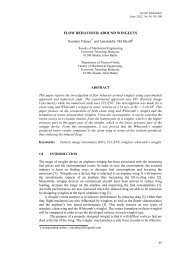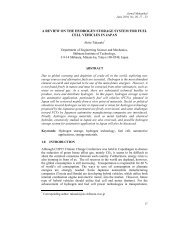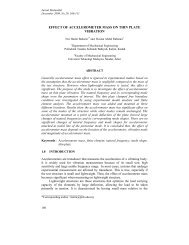Investigation of Gas Swirl Burner Characteristic ... - Jurnal Mekanikal
Investigation of Gas Swirl Burner Characteristic ... - Jurnal Mekanikal
Investigation of Gas Swirl Burner Characteristic ... - Jurnal Mekanikal
You also want an ePaper? Increase the reach of your titles
YUMPU automatically turns print PDFs into web optimized ePapers that Google loves.
<strong>Jurnal</strong> <strong>Mekanikal</strong> December 2011where -ν’ i,k is the molar stoichiometric coefficient for species i in reaction k (positivevalues for reactants, negative values for products), A is pre-exponential factor (consistentunits), T is temperature (˚K), n is temperature exponent (dimensionless), a and b arespecies exponents, and E A is activation energy for the reaction (J/kmol).The influence <strong>of</strong> turbulence time scale k/ε on the reaction rate was taken intoaccount by employing the Magnussen and Hjertager model (1976) [17] :mrR Rk = -4ν k M i ρε⁄kν Mrr(14)R Pk = 2 ν k M i ρε⁄k∑ PmP(15)∑υ MPPPwhere M i is molecular weight <strong>of</strong> species i (kg/kmol), m p is particle mass (kg), m r,P is massfraction <strong>of</strong> a particular reactant R and Product (P), s density (kg/m 3 ). The eddy breakupmodel relates the rate <strong>of</strong> reaction <strong>of</strong> dissipation <strong>of</strong> the Reactant (R) and Product(P),containing eddies, ε /k represents the time scale <strong>of</strong> the turbulent eddies following theeddy breakup model <strong>of</strong> Spalding (1972) [17].The model was applied, without modification, to the combusting. This ensured aconsistent representation <strong>of</strong> the flow and combustion physical processes so that thecomparisons between two cases would be insensitive to the particular turbulence andcombustion models employed. By assuming steady state, the component <strong>of</strong> changeaccording to time (∂/∂t) in the equation above was removed.2.1.2 Boundary ConditionThe boundary condition is as follows:• Composition <strong>of</strong> the gas mass fraction in the producer gas consists <strong>of</strong>: CO (25 %),H 2 (12 %), CH 4 (1.5 %) , and N 2 (51.5 %)• Mean velocity <strong>of</strong> producer gas was 5 m/s for biomass• Tangential air injection velocity was 9.7 m/s for biomass• Producer gas temperature is 200 o C and tangential air temperature was 27 o C.2.2 Experimental Set-UpThe gasification process was conducted on a downdraft gasifier and was equipped with acyclone, wet scrubber, and gas holding as in Figure 5. Air flow rate for the gasificationprocess is 190 lpm and fuel used is biomass (coconut shell), with each analysis shown inTable 1.Table 1: Proximate and ultimate analysis <strong>of</strong> coconut shellsProximate analysis (% weight)Ultimate Analysis (% weight)Moisture5.3 C 47.59Volatile Matter70.7 H 6.0Ash 6.26 O 45.52Fixed CarbonLow Heating Value (kj/kg)17.54 N 0.2222 S 0.0522



